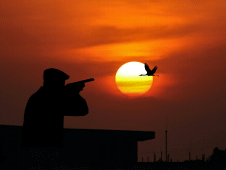
Human-induced pressures are driving biodiversity loss, but there is little information available on the spatial distribution of the impacts of these threats. In a novel approach to threat mapping, data on threats to species from the IUCN Red List have been used to model the global distribution of impacts of the top six threats to terrestrial vertebrates. For birds, this indicates that hunting and trapping is the most prevalent threat across much of the world, while climate change has the highest probability of impact in the polar regions, eastern Australia and South Africa. These data can be used to identify hotspots for threat mitigation, and regions in which increased sampling efforts are needed to improve our understanding of threats to species.

Biodiversity loss is driven by multiple threats, such as agriculture, hunting and trapping, logging, pollution, invasive species and climate change. For some of these threats, information on spatial patterns in intensity can be gathered through remote sensing. For example, satellite imagery can be used to monitor patterns and rates of deforestation, providing an indication of where species may be particularly threatened by logging. However, remote sensing cannot be used to gather data on pressures such as overexploitation, pollution and invasive species. Even for threats for which remote sensing data are available, these measure the distribution and potential intensity of the threatening process rather than the impact it has on species. Improving our knowledge of how threats and impacts on species are distributed around the globe is crucial for improving conservation responses.
All 11,000+ bird species have been assessed against the Categories and Criteria for the IUCN Red List of Threatened Species. As part of this assessment process, experts evaluate the threats affecting individual species across their global range using standardized methods. In a novel approach to threat mapping, Harfoot et al. (2021) used these data to model the global distribution of the impacts of the top six threats to terrestrial vertebrates. To do so, the ‘impact probability’ was estimated – the probability that a randomly selected species occurring in a given grid cell would be impacted in that cell by a particular threat.

The results show that hunting and trapping is the most prevalent threat to birds, with a high probability of species being impacted by this threat across most of the mapped range (Figure 1), and hunting and trapping having the highest impact probability of all threats in half of all grid cells (Figure 2). Particularly high probabilities of impact are found throughout northern Africa, Europe and Asia. Agriculture has the highest impact probability across much of South America, while the polar regions, eastern Australia and South Africa show the highest impact probabilities for climate change (Figure 2). The average impact probability of pollution and invasive species is low, although for the latter it is much higher on islands. The islands of Southeast Asia and Madagascar exhibit high probabilities of impact across all threats.
Spatial data on the impacts of threats are crucial for prioritising conservation actions. These data can be combined with information on species richness to identify hotspots of conservation risk, where large numbers of species are exposed to a high probability of a threat. Such areas can then be prioritised for threat mitigation. This approach can also help to identify data-poor areas in which increased sampling effort is needed to improve our understanding of threats to species.
References
Harfoot, M. B. J., Johnston, A., Balmford, A., Burgess, N. D., Butchart, S. H. M., Dias, M. P., Hazin, C., Hilton-Taylor, C., Hoffman, M., Isaac, N. J. B., Iversen, L. L., Outhwaite, C. L., Visconti, P. & Geldmann, J. (2021) Using the IUCN Red List to map threats to terrestrial vertebrates at global scale. Nat. Ecol. Evol, 5:1510-1519.
Compiled: 2022 Last updated: 2022
Recommended Citation:
BirdLife International (2022)
Mapping of global threats using the IUCN Red List reveals hunting and trapping is the most prevalent threat to birds.
Downloaded from https://datazone.birdlife.org/sowb/casestudy/mapping-of-global-threats-using-the-iucn-red-list-reveals-hunting-and-trapping-is-the-most-prevalent-threat-to-birds on 22/12/2024